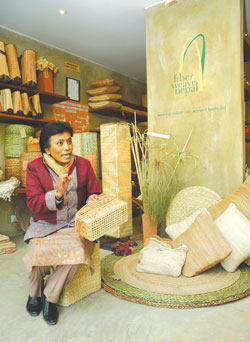|
|
Shyam Badan Shrestha is not afraid of working hard or of taking chances. She's been doing both since she was a child.
After Shrestha lost her father and most male relatives, she and her mother made the decision, unconventional 50 years ago, to live by themselves in Patan.
Shrestha would spend the day at school and, because she was good with her hands and money was tight, sew clothes for the neighbours at night. "Sometimes I'd work till two in the morning," Shrestha remembers. "I had no books, no time to do my homework, I don't know how I managed to do okay in school."
Shrestha breezed through school and college and in 1972, won a scholarship to study in the UK. She returned a year later to teach at a Kathmandu school. On the side, she devoured the craft books at her school library. "I read everything I could find on handicraft, knot work, macram?, crochet," Shrestha says.
In the early eighties, the handicraft business barely existed in Kathmandu. Shrestha taught herself and, in 1984, started Nepal Knotcraft Centre with two young women she had trained. "When I started the showroom, my intention was to teach, encourage, and give employment to women. I wanted them to learn skills they could use to support themselves," Shrestha explains. Eighty-four people, for the most part women, are employed at Nepal Knotcraft Centre's factory in Patan Industrial Estate.
The business has never been static, evolving as Shrestha learnt more. She used to import raw materials from India. Faced with the trade embargo in 1989, Shrestha travelled extensively around Nepal and realised the enormous potential various local materials have. "I found that there are 42 varieties of local plant materials that we can use!" she says gleefully.
Nepal Knotcraft has produced everything from cornhusk dolls to elegant, minimalist steel and paper lamps. Shrestha's designs and finished products draw on local traditions, but debunk the unfortunately often true image that products of well-intentioned skill development projects have sloppy workmanship and unattractive patterns.
In 2003, Shrestha started the Nepal Resource Development Centre to study natural resources, work with experts to develop technology to turn wastage into commercially viable materials, train women in rural Nepal, and find new markets. If you walk into Knotcraft's showroom on Kopundole these days, you're unlikely to see Shrestha. This energetic, positive woman is at work, behind the scenes, studying new fibres, designs, colours, and patterns.
Mallika Aryal



